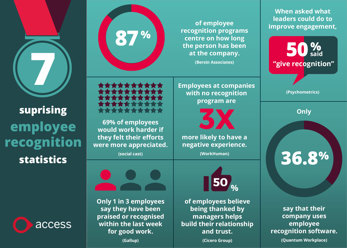 Talent management
Talent management
What are employee recognition schemes? A comprehensive guide for businesses
Reward and recognition programmes for employees can take many forms and getting it right can have a hugely significant impact on your business and the employees.
Whether it’s through simple peer-to-peer recognition, handing out long service awards, or rewarding a hard-working employee with a gift voucher, reward and recognition is all about showing your appreciation.
In this reward and recognition guide, we’ll cover everything from setting budgets and developing a winning strategy to utilising the right forms of reward and recognition for your business and your employees.
Read on for all this and more!
Contents
- What is employee recognition?
- The importance of employee recognition
- The purpose of recognition programmes for staff
- 10 low cost employee recognition ideas and examples
- Your reward and recognition system
- When to give employee recognition
- Building effective employee recognition schemes for long-term impact
What is employee recognition?
Employee recognition is the acknowledgement of a person or a group’s efforts or achievements that have contributed to the company’s goals and values. It’s an effective way for employers to show that they value and appreciate their team members, which can boost morale, motivation, and overall job satisfaction.
However, it takes many forms, so the definition can vary depending on how you recognise employees. The different types of employee recognition schemes can include public recognition, monetary, verbal, and more. We discuss some of the low-cost options available later in this blog.
The importance of employee recognition
For many CEO’s and business leaders, employee recognition is at the back of their mind, behind all kinds of other important business issues. However, the research suggests that recognition and rewards are linked to increased productivity, lower staff turnover and higher levels of motivation.
The importance of recognition is clear when you consider that not recognising employees could have the reverse effect.
From a HR point of view, the last thing any company wants is high staff turnover and unmotivated, unproductive employees.
The purpose of recognition programmes for staff
The purpose of these types of programmes differs depending on the business. However, typically you’ll find that they’re put in place to increase loyalty and retention.
They’re also typically used to improve performance through reinforcement of positive behaviour.
1. Boost motivation and productivity
Employees that know their efforts are noticed and valued are more likely to go the extra mile. Recognition programmes for staff can reinforce positive behaviours and encourage employees to maintain high performance. A Korn Kerry survey indicates that only 60% of UK employees indicating that they are motivated to work above and beyond their roles, compared to 71% of employees globally.
2. Enhance employee satisfaction and morale
Building a culture of recognition can create a positive work environment, which can translate to happier employees. Employees who feel appreciated experience higher job satisfaction, which can improve morale. A focus on employee wellbeing is more important than ever with an Owllabs report finding that work anxiety is on the rise with 38% saying their stress levels increased compared to last year.
3. Reduce turnover and improve retention
Underappreciated employees may look for other opportunities. Consistent recognition programmes for staff helps to build loyalty and reduce turnover. The hiring process can prove expensive and time consuming, therefore retaining staff is always the preferable option. The CIPD reports that hiring costs are between £1,500 - £2,000 per employee.
4. Strengthen company culture.
A culture of appreciation fosters trust and collaboration, which feeds into a supportive and inclusive work environment.
5. Encourages innovation and creativity
Employees who feel valued and reassures may look to take risks, suggest new ideas, and innovate. Promoting creativity with recognition programmes for staff can build a culture of learning and improvement.
6. Healthy competition and goal achievement
Public recognition or reward programmes can drive friendly competition among team members, motivating them to achieve their goals and excel in their roles.
7. Strengthen relationships
Recognition can help build trust between managers and employees. When managers consistently acknowledge the hard work of their teams, it improves communication and strengthens the relationship.
7 key employee recognition statistics

10 low cost employee recognition ideas and examples
There are loads of simple ways you can reward and recognise employees. Some can be as simple as just saying “thank you” more often or introducing employee of the month.
The best employee recognition schemes go that little bit further. Putting a little bit more thought into how you reward employees can make a big difference.
Here are 10 low cost employee recognition ideas that you may not have thought of:
- Arrange a one-on-one lunch
- Write about the person in a company-wide email
- Include them in a company newsletter
- Leave a thank you note on their desk
- Give them a longer lunch break or let the person leave early one day
- Show recognition for them at the start of a staff meeting
- Give them a gift card
- Send them a thank you letter home
- Give a donation to a charity of their choice
- Show appreciation and recognise employees on social media
Your reward and recognition system
An employee benefits platform can be a great place to reward and recognise employees. Not only can it drive engagement with the platform itself, it can make rewarding employees more convenient for everyone.
For example, you could use your benefits platform to display all awards given to employees for everyone to see. You can then notify employees through the platform that they or another employee has received an award, such as employee of the month for example. Rather than just sending it as an email, this could encourage employees to log on to their employee benefits platform more often.
Combining your employee recognition platform with your employee benefits platform makes sense for HR and for employees in tying everything together and creating a better admin and user experience.
Find out how Reach PLC delivered over £100,000 in rewards with their combined employee benefits and rewards platform.
When to give employee recognition
Timeliness of employee recognition is crucial. Often, non-monetary rewards are more effective for this very reason.
Where an employee has to wait to be recognised, the impact of the recognition wears off over time.
Typically, it’s best to give employee recognition as soon as it’s due.
The above employee recognition examples give an idea of what scenarios to give employee recognition, but the timeliness of the recognition itself is also key.
Building effective employee recognition schemes for long-term impact
You’ll want to avoid being that company that begins recognising and rewarding their employees more, only for their programme to slowly fade out. Employee recognition should be part of the culture of the business in order for the business to reap the benefits long-term.
The last thing you’ll want is for your employee recognition schemes to be seen as a failed attempt at improving performance and retention.
As mentioned, many CEO’s have loads of priorities and things to think about before they even consider employee recognition and the importance of recognition is underestimated. However, if done and done well it can be a hugely valuable asset for any business!
Flexible benefits boost motivation and engagement, especially when powered by the right platform. Our Flexible Benefits system offers a wide range of ready-made schemes, plus the ability to create your own. Customise beyond just the benefits, with unique rules for different employee groups, all on one platform with dedicated support.
It also integrates seamlessly with your HR software solutions . Our AI-driven PeopleXD Evo solution manages your entire employee lifecycle in a unified, modular system. Powerful analytics track benefits usage and engagement, allowing for data-driven improvements.

See our employee benefits platform in action
Learn more with our HR and Payroll blogs
Our HR and payroll blogs offer advice and guidance from industry experts.

 AU & NZ
AU & NZ
 SG
SG
 MY
MY
 US
US
 IE
IE










